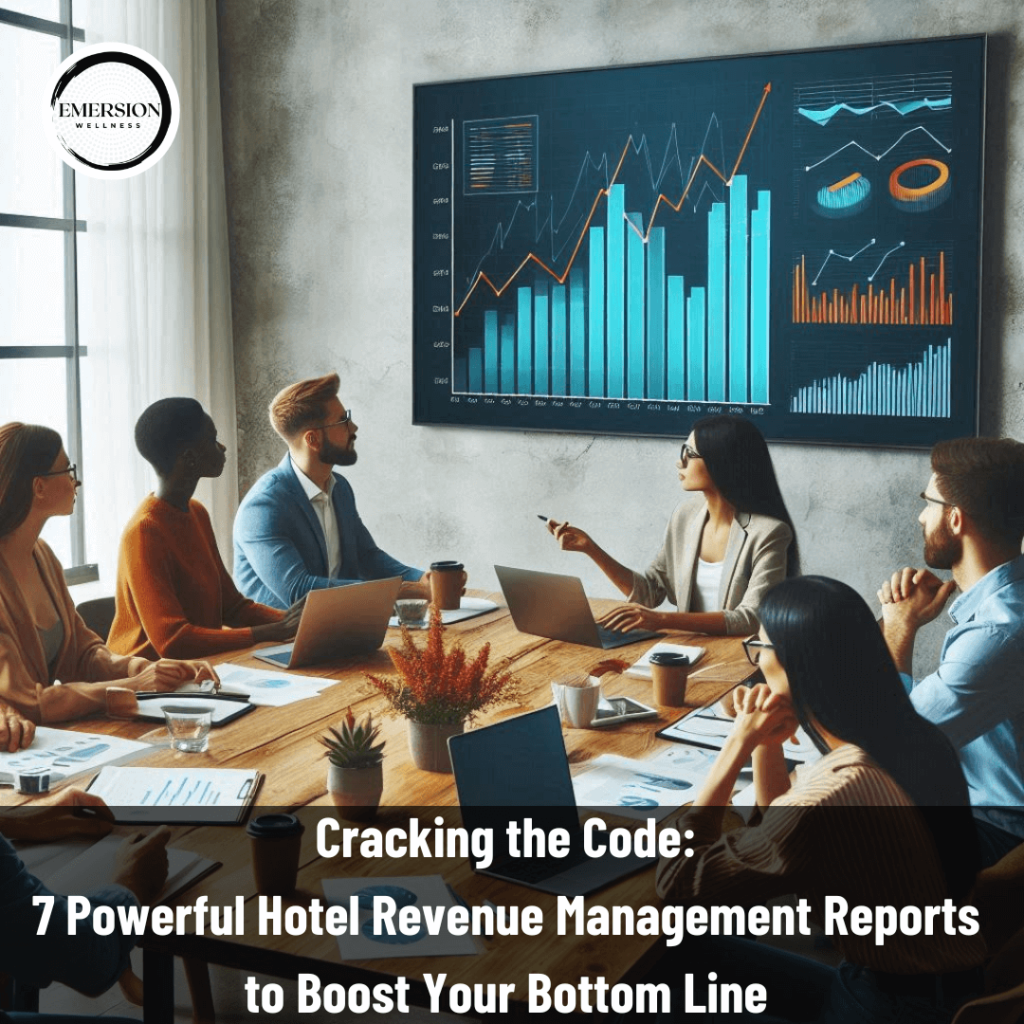In the fiercely competitive world of hospitality, hoteliers constantly quest to maximise. Fortunately, a treasure trove of insightful reports awaits you, offering data-driven insights to optimise room optimisation, increase occupancy, and boost your bottom line. Whether you're a seasoned hotelier or just starting your journey, this comprehensive guide explores the power of hotel revenue management reports. We'll delve into seven crucial reports and demonstrate how to leverage them for maximum impact.
Critical Takeaways:
- Uncover hidden revenue opportunities through insightful hotel revenue management reports.
- Understand key performance indicators (KPIs) to measure your hotel's financial health.
- Utilise data to make informed pricing, marketing, and inventory management decisions.
- Implement best practices for generating and interpreting hotel revenue management reports.
Unveiling the Power of Hotel Revenue Management Reports
Hotel revenue management reports are the lifeblood of informed decision-making in the hospitality industry. These reports provide a wealth of data and insights, allowing you to track performance, identify trends, and make strategic adjustments to optimise natural optimisation.
Demystifying Key Performance Indicators (KPIs)
Before diving into specific reports, it's crucial to understand the key performance indicators (KPIs) that form the foundation of hotel revenue management reports. Here are some essential KPIs to familiarise yourself with:
- Occupancy Rate: This metric reflects the percentage of your rooms occupied on a given date or period.
- Average Daily Rate (ADR): The average price you charge per occupied room per night.
- Revenue Per Available Room (RevPAR): Combines occupancy rate and ADR to measure overall revenue generation per available room.
- Total Revenue: The total income generated by your hotel from all sources, including rooms, food & beverage, spa, and other services.
- Guest Satisfaction Scores: Feedback from guests regarding their overall experience.
Harnessing the Power of Daily Sales Reports
Daily sales reports offer a snapshot of your hotel's performance on a specific date. This report typically details room revenue, occupancy rate, booked and cancelled reservations, and revenue from ancillary services like spa treatments or restaurant sales.
- Benefits: Daily sales reports provide valuable insights into real-time performance, allowing you to react quickly to fluctuations in demand. This data can be used for dynamic pricing adjustments or targeted marketing campaigns to fill empty rooms.
- Real-Life Example: Imagine a hotel in a beach destination experiences lower-than-expected occupancy on a Tuesday. By analysing the Analysingles report, the hotel manager can quickly implement a flash sale or targeted social media promotion to attract last-minute bookings and boost occupancy.
Optimising Revenue with Pick-Up Reports
Pick-up reports provide detailed information on bookings made within a specific timeframe, typically within the past 24 to 72 hours. These reports reveal valuable insights regarding booking trends, lead sources, and guest demographics.
- Benefits: Pick-up reports help you identify the most effective marketing channels for attracting guests and pinpoint peak booking periods. This information can guide your marketing strategy and pricing decisions to maximise revenue during high-demand periods.
- Real-Life Example: A hotel manager analysing picanalysingrts discovers a recent booking surge from a specific online travel agency (OTA). This data indicates the effectiveness of the hotel's partnership with this OTA and may encourage further collaboration for targeted promotions.
Gaining Market Insights with Market Mix Reports
Market mix reports analyse the canalisation of your revenue stream, revealing how different segments contribute to your overall income. This report typically breaks down revenue by room type, guest segment (business, leisure), source of booking (direct, OTA), and rate plan (corporate, weekend package).
- Benefits: Market mix reports provide valuable insights into the most profitable segments and booking channels. You can leverage this information to optimise your efforts, tailor your offerings, and negotiate better deals with OTAs.
- Real-Life Example: After analysing its analysis report, a hotel discovers that a significant portion of its revenue comes from corporate bookings during the week. With this knowledge, the hotel can focus its marketing efforts on attracting business travellers and negotiating corporate rates with local companies.
- Challenges: Market mix reports can become complex, especially for hotels with multiple properties or diverse data visualisation tools to simplify the analysis and identify key trends.
- Best Practices: To maximise the market mix reports, segment your data by different periods (monthly, quarterly, yearly) to identify seasonal trends. Compare your hotel's performance to industry benchmarks to identify areas for improvement.
Uncovering Pricing Trends with Rate Analysis Reports
- Rate analysis reports provide a detailed overview of your pricing performance, allowing you to track changes in average daily rates (ADRs), occupancy rates, and revenue per available room (RevPAR). These reports help you identify pricing trends, evaluate the effectiveness of your rate strategies, and identify opportunities for optimisation analysis reports, which enable you to measure the impact of different pricing strategies on your revenue. You can locate which rate plans perform well and adjust your pricing accordingly.
- Real-Life Example: A hotel analysing its analysis report notices a decline in ADR during the shoulder seasons. This information prompts the hotel to explore promotional rate plans or package deals to stimulate demand and maintain revenue.
- Challenges: Accurate rate analysis requires comprehensive data collection and analysis. When interpreting the results, factors such as competition, market demand, and seasonality must be considered.
- Best Practices: To maximise rate analysis reports, compare your pricing performance to industry benchmarks and competitor rates. Experiment with different pricing strategies to identify the most effective approach for your hotel.
- Segments and booking channels. You can leverage H2: Uncovering Guest Behavior with Segmentation Analysis Reports.
Segmentation analysis reports delve into guest demographics and booking patterns, helping you identify distinct customer segments and tailor your offerings accordingly. Understanding your guests' preferences allows you to create personalised, optimised pricing and increase customer loyalty.
- Benefits: Segmentation analysis reports enable you to identify high-value guest segments and create targeted marketing campaigns. You can also optimise your inventory and pricing strategies to maximise and minimise customer groups.
- Real-Life Example: A hotel, after analysing its analysis report, discovers that many of its guests are leisure travellers with families. Based on this insight, the hotel introduces family-friendly packages, including children's activities and unique room amenities.
- Challenges: Collecting and analysing data can be time-consuming and require robust data management systems. Additionally, ensuring data privacy is essential to maintaining guest trust.
- Best Practices: Leverage guest feedback surveys and loyalty programs to gather valuable data for segmentation analysis—Utilise data visualisation to visualise patterns and trends effectively.

Optimising Revenue Channels with Distribution Analysis Reports
Distribution analysis reports provide insights into the performance of your various sales channels, including online travel agencies (OTAs), direct bookings, and group bookings. By understanding the effectiveness of each channel, you can allocate your marketing budget accordingly and negotiate better deals with partners.
- Benefits: Distribution analysis reports help you identify top-performing channels and optimise your implementation strategy. You can also measure your marketing efforts' return on investment (ROI) and identify improvement areas.
- Real-Life Example: After analysing its analysis report, a hotel discovered that direct bookings had increased significantly since implementing a loyalty program. This data encourages the hotel to invest more in direct booking channels and enhance the loyalty program.
- Challenges: Attributing revenue to specific channels can be complex, mainly when guests use multiple booking sources. Advanced attribution models are essential to accurately measure channel performance.
Best Practices: Regularly monitor distribution channel performance and adjust your strategy accordingly. Consider implementing a channel management system to streamline distribution and optimise rate Revenue with Comprehensive Hotel Revenue Management Reports.
To fully leverage the power of hotel revenue management reports, data from multiple sources must be combined and analysed holistically. By integrating data from different reports, you can comprehensively understand your hotel's performance and identify opportunities for revenue growth.
- Benefits: Comprehensive hotel revenue management reports provide a holistic view of your hotel's performance, enabling you to make informed decisions based on multiple data points.
- Real-Life Example: A hotel combines data from daily sales reports, pick-up reports, and segmentation analysis to identify a decline in occupancy during a specific week. The hotel discovers a need for targeted marketing efforts for a particular guest segment by analysing the analysis. This insight prompts the hotel to create a targeted campaign to boost occupancy during that week.
- Challenges: Integrating data from multiple sources can be technically challenging and requires data cleaning and standardisation. Invest in a robust revenue management system (RMS) that can consolidate data from different sources and provide advanced reporting capabilities. Collaborate with your IT department to ensure data integrity and accuracy.
The Role of Technology in Hotel Revenue Management Reporting
Technology plays a crucial role in generating and analysing high-level management reports. Advanced revenue management systems (RMS) and business intelligence (BI) tools can automate data collection, analysis, and reporting processes.
- Benefits: Technology enables you to access real-time data and generate reports quickly and efficiently. This allows you to make timely decisions based on the latest information.
- Real-Life Example: A hotel uses a Cloutilises RMS that provides real-time occupancy rate and pricing data. This allows the hotel to adjust rates dynamically based on demand fluctuations.
- Challenges: Implementing new technology can require significant investment and training. Additionally, ensuring data security and privacy is crucial.
- Best Practices: Select a revenue management system that aligns with your hotel's needs and budget. Provide adequate training to your staff on how to use the system effectively.
The Importance of Data Visualization
Data visualisation visualisation for effectively communicating insights from hotel revenue management reports. You can quickly identify trends, patterns, and anomalies by presenting data in visual formats such as graphs, charts, and dashboards.
- Benefits: Data visualisation and facilitates decision-making. It also helps you communicate complex information effectively to stakeholders.
- Real-Life Example: A hotel uses interactive dashboards to display real-time key performance indicators (KPIs). This allows the management team to monitor performance and identify potential issues quickly.
- Challenges: Creating compelling data visualisation skills and an understanding of data storytelling.
- Best Practices: Use clear and concise labels and titles for your visualisation chart types to represent the data effectively.
Turning Insights into Action
The ultimate goal of hotel revenue management reports is to drive actionable insights and improve business performance. By leveraging these reports' data and insights, you can optimise occupancy and enhance the guest experience.
- Benefits: Actionable insights lead to improved decision-making, increased revenue, and enhanced profitability.
- Real-Life Example: A hotel utilises rate utilises reports to identify opportunities for upselling and cross-selling. By implementing targeted upselling strategies, the hotel increases average daily revenue.
- Challenges: Turning insights into action requires effective communication and collaboration across departments.
- Best Practices: Establish a regular reporting cycle and share insights with relevant stakeholders. Create a culture of data-driven decision-making within your organisation.
Organisational revenue management reports are indispensable tools for maximising profitability. By understanding the different types of reports, leveraging technology, and effectively analysing data, you can gain valuable insights into your hotel's performance and make data-driven decisions.
Remember, the key to success lies in consistently monitoring your reports, identifying trends, and taking action to optimise your strategy. By embracing the power of hotel revenue management reports, you can elevate your hotel's performance and achieve sustainable growth.
Emersion Wellness: Your Partner in Hotel Revenue Optimization
At Emersion Wellness, we specialise in specialists who unlock their full revenue potential through data-driven strategies and innovative solutions. Our team of experts can provide you with tailored insights and recommendations to optimise your performance.
Contact us today to learn how we can help you leverage the power of hotel revenue management reports and achieve your business goals. Our weight loss program is just one example of how we can help you attract new guests and increase overall profitability.
Let Emersion Wellness be your partner in achieving hotel excellence.
FAQs
What are the most essential hotel revenue management reports?
The most crucial hotel revenue management reports include:
- Daily sales reports.
- Pick-up reports.
- Market mix reports.
- Rate analysis reports.
- Segmentation analysis reports.
- Distribution analysis reports.
How often should I analyse hotel analyse management reports?
The frequency of report analysis depends on your hotel's size and complexity. However, it's generally recommended to analyse daily reports to identify trends and make timely adjustments.
What are the key challenges in using hotel revenue management reports?
Key challenges include data quality, data integration, and data analysis complexity. Additianalysingnsuring data privacy and security is crucial.
How can I improve the accuracy of my hotel revenue management reports?
To improve report accuracy, ensure data consistency across different systems, implement data validation processes, and regularly review and update report definitions.
What is the role of technology in hotel revenue management reporting?
Technology is crucial in automating data collection, analysis, and reporting processes. Advanced revenue management systems (RMS) and business intelligence (BI) tools can provide valuable insights and support data-driven decision-making.
How can I communicate the value of hotel revenue management reports to my team?
Communicate the benefits of using reports, provide training on data analysis, and involve your team in the reporting process. Showcase success stories and highlight how reports have led to improved performance.
What are some best practices for using hotel revenue management reports?
Best practices include:
- Setting clear objectives.
- Using data visualisation tools.
- Regularly visualisations.
- Sharing insights with relevant stakeholders.
How can I measure the return on investment (ROI) of my hotel revenue management efforts?
To measure ROI, compare your hotel's performance before and after implementing revenue management strategies. Track key performance indicators (KPIs) such as RevPAR, occupancy rate, and average daily rate (ADR) to assess the impact of your efforts.
How can I ensure data privacy and security when using hotel revenue management reports?
Implement robust data security measures, limit access to sensitive information, and comply with data protection regulations. Review and update security protocols regularly.
What are the future trends in hotel revenue management reporting?
Future trends include increased use of artificial intelligence (AI) and machine learning for predictive analytics, integration of data from various sources, and real-time reporting capabilities.
Ready to unlock the full potential of your hotel and drive significant revenue growth? Visit Emersion Wellness today at Emersion Wellness and explore how our innovative strategies can transform your hotel's success.

I'm Nathan Baws, a nutrition nerd, exercise and weight loss expert, and an unwavering advocate for good health. As the founder of Emersion Wellness, I'm passionate about crafting Seamless Weight Loss Programs to supercharge hotel revenue and transform lives. We've pioneered the World's First Plug & Play Weight Loss Programs for top hotels and resorts, sparking a wellness revolution. Beyond my professional journey, you'll often find me hiking, swimming, and riding the waves, embracing every moment in nature. Join me on this exhilarating journey towards diet, health and wellness.

